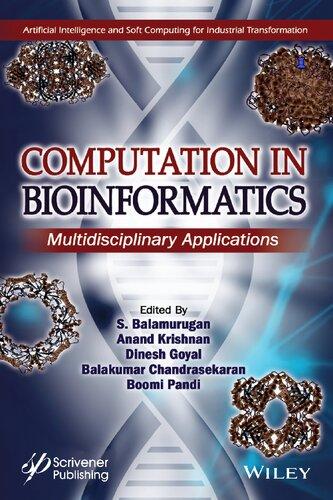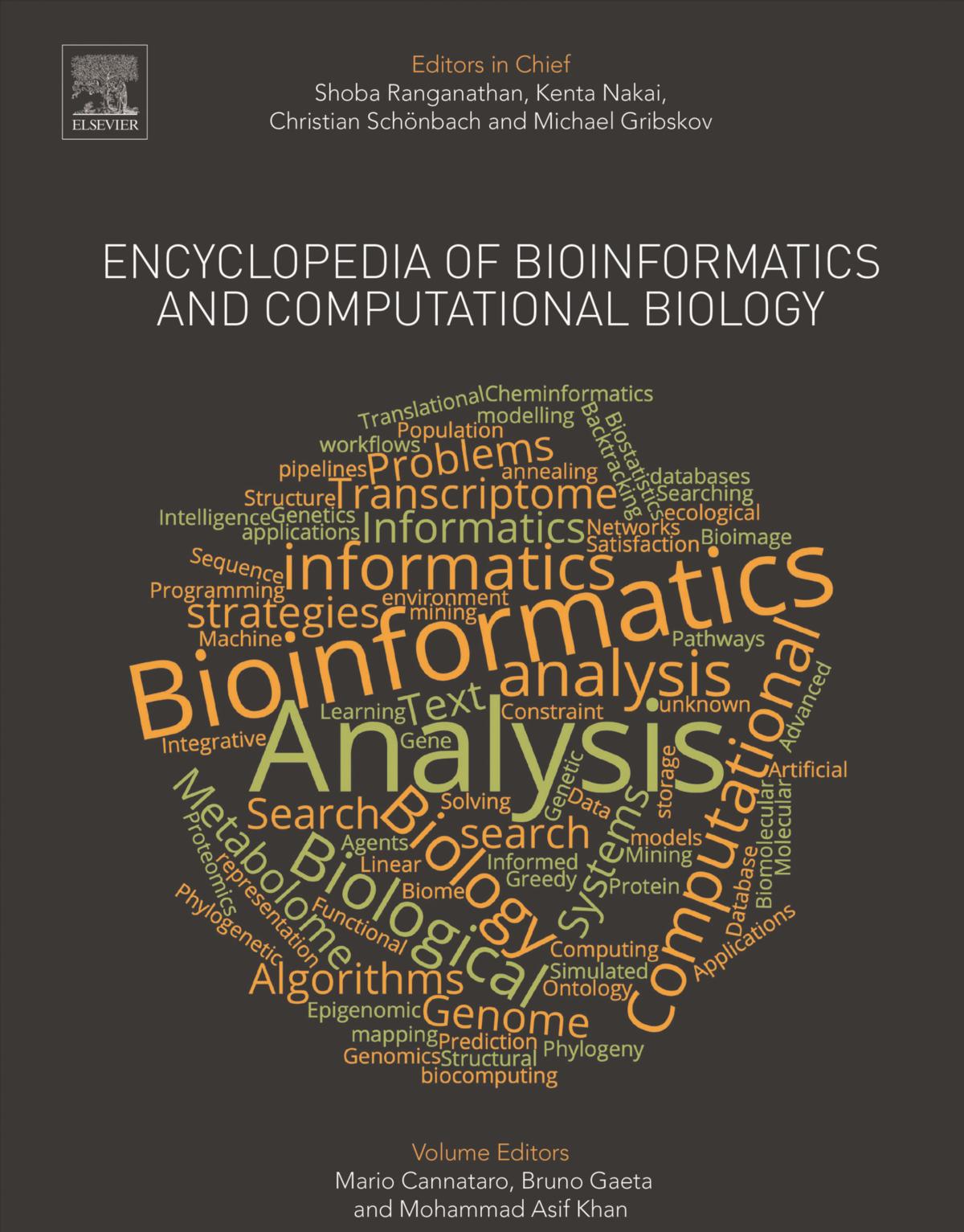https://ebookmass.com/product/computation-in-bioinformatics-
Instant digital products (PDF, ePub, MOBI) ready for you
Download now and discover formats that fit your needs...
Cell biology : translational impact in cancer biology and bioinformatics 1st Edition Mitchell
https://ebookmass.com/product/cell-biology-translational-impact-incancer-biology-and-bioinformatics-1st-edition-mitchell/
ebookmass.com
Evolutionary Computation in Scheduling 1. Edition Amir H Gandomi
https://ebookmass.com/product/evolutionary-computation-inscheduling-1-edition-amir-h-gandomi/
ebookmass.com
Encyclopedia of Bioinformatics and Computational Biology: ABC of Bioinformatics Shoba Ranganathan
https://ebookmass.com/product/encyclopedia-of-bioinformatics-andcomputational-biology-abc-of-bioinformatics-shoba-ranganathan/ ebookmass.com
Psychotherapy for the Advanced Practice Psychiatric Nurse, Second Edition: A How To Guide for Evidence Based Practice 2nd Edition, (Ebook PDF)
https://ebookmass.com/product/psychotherapy-for-the-advanced-practicepsychiatric-nurse-second-edition-a-how-to-guide-for-evidence-basedpractice-2nd-edition-ebook-pdf/ ebookmass.com
Bailey & Scott’s Diagnostic Microbiology 14th Edition
Patricia M. Tille
https://ebookmass.com/product/bailey-scotts-diagnosticmicrobiology-14th-edition-patricia-m-tille/
ebookmass.com
Show Me Wonders: An M/M Second Chance Standalone (Water, Air, Earth, Fire Book 3) Riley Nash
https://ebookmass.com/product/show-me-wonders-an-m-m-second-chancestandalone-water-air-earth-fire-book-3-riley-nash/
ebookmass.com
Dangerous Engagement Box Set: Complete Series Books 1-3 Charlotte Byrd
https://ebookmass.com/product/dangerous-engagement-box-set-completeseries-books-1-3-charlotte-byrd/
ebookmass.com
Foundations of Institutional Reality Andrei Marmor
https://ebookmass.com/product/foundations-of-institutional-realityandrei-marmor/
ebookmass.com
Infinity, Causation, and Paradox Alexander R Pruss
https://ebookmass.com/product/infinity-causation-and-paradoxalexander-r-pruss/
ebookmass.com
https://ebookmass.com/product/modern-china-financial-cooperation-forsolving-sustainability-challenges-1st-ed-edition-cary-krosinsky/
ebookmass.com
Computation in Bioinformatics
Multidisciplinary Applications
Edited by
S. Balamurugan
Founder & Chairman, Albert Einstein Engineering and Research Labs (AEER Labs), Vice Chairman, Renewable Energy Society of India (RESI), India
Anand Krishnan
NRF-DSI Innovation Fellow, Department of Chemical Pathology
University of the Free State (Bloemfontein Campus), Bloemfontein, South Africa
Dinesh Goyal
Poornima Institute of Engineering & Technology, Jaipur, India
Balakumar Chandrasekaran
Faculty of Pharmacy, Philadelphia University, Amman, Jordan and
Boomi Pandi
Department of Bioinformatics, Alagappa University, Karaikudi, India
This edition first published 2021 by John Wiley & Sons, Inc., 111 River Street, Hoboken, NJ 07030, USA and Scrivener Publishing LLC, 100 Cummings Center, Suite 541J, Beverly, MA 01915, USA © 2021 Scrivener Publishing LLC
For more information about Scrivener publications please visit www.scrivenerpublishing.com.
All rights reserved. No part of this publication may be reproduced, stored in a retrieval system, or transmitted, in any form or by any means, electronic, mechanical, photocopying, recording, or otherwise, except as permitted by law. Advice on how to obtain permission to reuse material from this title is available at http://www.wiley.com/go/permissions.
Wiley Global Headquarters
111 River Street, Hoboken, NJ 07030, USA
For details of our global editorial offices, customer services, and more information about Wiley products visit us at www.wiley.com.
Limit of Liability/Disclaimer of Warranty
While the publisher and authors have used their best efforts in preparing this work, they make no representations or warranties with respect to the accuracy or completeness of the contents of this work and specifically disclaim all warranties, including without limitation any implied warranties of merchantability or fitness for a particular purpose. No warranty may be created or extended by sales representatives, written sales materials, or promotional statements for this work. The fact that an organization, website, or product is referred to in this work as a citation and/or potential source of further information does not mean that the publisher and authors endorse the information or services the organization, website, or product may provide or recommendations it may make. This work is sold with the understanding that the publisher is not engaged in rendering professional services. The advice and strategies contained herein may not be suitable for your situation. You should consult with a specialist where appropriate. Neither the publisher nor authors shall be liable for any loss of profit or any other commercial damages, including but not limited to special, incidental, consequential, or other damages. Further, readers should be aware that websites listed in this work may have changed or disappeared between when this work was written and when it is read.
Library of Congress Cataloging-in-Publication Data
ISBN 978-1-119-65471-1
Cover image: Pixabay.Com
Cover design by Russell Richardson
Set in size of 11pt and Minion Pro by Manila Typesetting Company, Makati, Philippines
Vivek P. Chavda, Amit Sorathiya, Disha Valu and Swati Marwadi
8
12.3
S. Muthumanickam, P. Boomi, R. Subashkumar, S. Palanisamy, A. Sudha, K. Anand, C. Balakumar, M. Saravanan, G. Poorani, Yao Wang, K. Vijayakumar and M. Syed Ali 13.1
and Murugesan Chandrasekaran
Balajee Ramachandran, Saravanan Muthupandian and Jeyakanthan Jeyaraman
Preface
The past couple of years will be remembered for the COVID-19 pandemic and ensuing lockdowns, wherein almost every country saw a series of lockdowns and consequent suffering. To overcome the pandemic, the discovery of vaccines and other alternative therapies were attempted worldwide. Currently, the discovery of new solutions to the pandemic can be facilitated through the use of promising bioinformatics techniques and integrated approaches. Hence, this book provides readers with an understanding of the use of bioinformatics tools in new drug design and the discoveries which are inevitable in the present situation. The book covers a broad spectrum of the bioinformatics field, starting with the basic principles, concepts, and application areas under multidisciplinary sections. Also covered is the role of bioinformatics in drug design and discovery, including aspects of molecular modeling. Some of the chapters provide detailed information on bioinformatics-related topics, such as silico design, protein modeling, DNA microarray analysis, DNA-RNA barcoding, and gene sequencing, all of which are currently needed in the industry. Also included are specialized topics, such as bioinformatics in cancer detection, genomics and proteomics, which are highly relevant to the present scenario. Moreover, a few chapters explain highly advanced topics, like machine learning and covalent approaches to drug design and discovery, all of which are significant in pharma and biotech research and development. Therefore, the contents of this book will be useful for students, scientists, researchers, and professionals working in the field of bioinformatics, drug design, pharmacoinformatics and medicinal chemistry under the umbrella of academia and industry.
Preface
Our sincere gratitude especially goes to all the contributors for their useful insights concerning bioinformatics and its multidisciplinary applications. We sincerely thank Scrivener Publishing for their assistance, constant support, and patience in finalizing this book.
S. Balamurugan Coimbatore, India
Krishnan Anand Bloemfontein, South Africa
Dinesh Goyal Jaipur, India
Balakumar Chandrasekaran Amman, Jordan
Boomi Pandi Karaikudi, India
Bioinfomatics as a Tool in Drug Designing
Rene Barbie Browne, Shiny C. Thomas and Jayanti Datta Roy* Department of BioSciences, Assam Don Bosco
University, Sonapur, Assam, India
Abstract
Drug discovery is the method of identifying and validating a disease target and discovering and developing a chemical compound which can interact with its specific target. This process is very complex and time consuming, requiring multidisciplinary expertise and innovative approaches. To overcome the difficulties and complexity, in silico approach is used that reduces the time and expenditure. This chapter addresses the importance of bioinformatics in drug designing. It focuses on bioinformatics tools like AutoDock, LigPlot, FlexX, and many other softwares which play an important role in rational designing of drug. Thus, the main goal of this chapter is to provide an overview of the importance of bioinformatics tools in designing a drug.
Keywords: AutoDock, LigPlot, FleX, GenBank, SWISS-PROT, PDB
1.1 Introduction
Bioinformatics is a multidisciplinary field of life sciences merging biology, computer science, and information technology into a single discipline [1]. A wide range of subject areas is included in this field. These subject areas are structural biology, gene expression studies, and genomics. Computational techniques play an important role analyzing information that are associated with biomolecules on a large scale [2].
The main goal of bioinformatics aims toward better understanding of living cells and how it functions at the molecular level. Besides being
*Corresponding author: jayanti.roy@dbuniversity.ac.in
S. Balamurugan, Anand Krishnan, Dinesh Goyal, Balakumar Chandrasekaran and Boomi Pandi (eds.) Computation in Bioinformatics: Multidisciplinary Applications, (1–24) © 2021 Scrivener Publishing LLC
essential for basic genomic and molecular biology research, bioinformatics plays a pivotal role on many areas of biotechnology and biomedical sciences [3]. In this aspect, bioinformatics play a vital role in designing of novel drugs. The interactions between protein and ligand investigated computationally provide rational basis for rapidly identifying novel synthetic drugs [4]. Information available regarding the 3D structure of proteins makes it easier to design molecule in such a way that they are capable of binding to the receptor site of a target protein with great affinity and specificity. Consequently, it significantly reduces time and cost necessary to develop drugs with higher potency, fewer side effects, and less toxicity than using the traditional trial-and-error approach.
This field of computational study has also reduced the sacrifice of animals in research. Nowadays, the number of potential drug candidate molecules is increasing with the use of computational simulation and informatics methods. These methods help in reducing the number of animals sacrificed in drug discovery process [5]. By efficient use of existing knowledge, computational studies have also helped in reducing the number of animal experiments which is required in basic biological sciences [6].
Bioinformatics tools are now appreciably used for developing novel drugs, leading to a new variety of research. Discovery and development of a new drug is generally very complex process consuming a whole lot of time and resources. So, bioinformatics techniques in designing tools are now broadly used so as to growth the efficiency of designing and developing a novel synthetic drug [4]. Drug discovery is the method of identifying, validating a disease target, followed by designing a chemical compound which can interact with that target resulting in inhibition of biological response which increases the rate of the disease. All these processes can be supported by various computational tools and methodology. Some of the factors which need to be observed during identification of the drug target are sequences of protein and nucleotide, mapping information, functional prediction, and data of protein and gene expression. Bioinformatics tools have helped in collecting the information of all these factors leading to the development of primary and secondary databases of nucleic acid sequences, protein sequences, and structures. Some of the commonly used databases include GenBank, SWISS-PROT, PDB, PIR, SCOP, and CATH. These databases have become indispensable tools to accumulate information regarding disease target. Databases like PubChem and ChemFaces provide structural and biological information of known drug like compounds which helps to identify the drug target for designing drug in research field [7]. These databases help in saving time, money, and efforts of the researchers.
Designing of drugs using bioinformatics tools can be broadly classified into two main categories, viz.,
a) Structure-based drug design (SBDD)
b) Ligand-based drug design (LBDD)
a) Structure-Based Drug Design (SBDD): Designing of drugs using SBDD method utilizes the 3D structure of the biological target which can be acquired via X-ray crystallography or NMR spectroscopy techniques [8]. Candidate drugs can be predicted on the basis of its binding affinity to the target using the structural information of the biological target. If the structure of the biological target/receptor is unavailable, then in that case, the structure can be predicted using homology modeling. It usually requires the amino acid sequence of the target protein, which when submitted constructs models that can be compared with the 3D structure of similar homologous protein (template). In order to know the interactions or bio-affinity for all tested compounds, molecular docking of each compound is performed into the binding site of the target, predicting the electrostatic fit between them.
b) Ligand-Based Drug Design (LBDD): In this method of designing drug, the structural information of the small molecule/compound is known which binds to the target. The compounds/ligands which help in developing a Pharmacophore model possess all the important structural features necessary for binding to a target active site. Most common techniques used in this approach are Pharmacophore modeling and quantitative structure activity relationships (3D QSAR). These techniques are used in developing models with predictive ability that are suitable for lead identification and optimization [9]. Compound which are similar in structure also possess the same biological interaction with their target protein.
1.2 Steps Involved in Drug Designing
The flowchart in Figure 1.1 has been constructed to outline the phases that are involved in drug designing using in-silico approaches.
TARGET IDENTIFICATION
DETECTION OF MOLECULAR SITE IN THE TARGET PROTEIN
MOLECULAR MODELING
VIRTUAL SCREENING
MOLECULAR DOCKING
QSAR (QUANTITATIVE STRUCTURE-ACTIVITY RELATIONSHIP)
PHARMACOPHORE MODELING
MOLECULAR DYNAMICS SIMULATION
SOLUBILITY OF MOLECULE
ADME PREDICTION
Figure 1.1 Flowchart of in silico approaches in drug designing.
1.2.1 Identification of the Target Protein/Enzyme
Before designing a novel synthetic drug, one needs to know all about the signaling pathways which lead to the disease. A novel drug needs to be designed in such a way that can interact with the target protein without interfering with normal metabolism. The most conventional method is to block the activity of the protein with a small molecule which can be the prospective drug. Virtual screenings of the target for compounds that can bind and inhibit the protein/enzyme are now performed using various bioinformatics softwares. Another strategy is to find other proteins which can regulate the activity of the target by binding and forming a complex, thereby controlling the disease.
• PDB: The Protein Data Bank (PDB) is the repository of information about the 3D structure structures of biological molecules which include nucleic acids and proteins (https:// www.rcsb.org). The main function of this database is to provide 3D structural data of all the organisms which includes yeast, bacteria, plants, and other animals including humans. Techniques such as X-ray crystallography, electron microscopy, and nuclear magnetic resonance (NMR) spectroscopy help in extracting the information of the 3Dstructure of the macromolecules [10].
• Swiss Target Prediction: It is a web server which can accurately predict the targets of bioactive molecules based on similarity measures with known ligands [11]. In this web server, the predictions can be carried out in five different organisms, and mapping predictions by homology. The SwissTargetPrediction server is easily is accessible and is free of charge without any registration (www.swisstargetprediction.ch)
• SPPIDER: The SPPIDER protein interface recognition is a server that can be used to predict residues that needs to be in the putative protein interfaces by considering single protein chain with resolved 3D structure [12]. It can analyze protein-protein complex with given 3D structural information and can identify residues that are being in contact (http://sppider.cchmc.org/).
1.2.2 Detection of Molecular Site (Active Site) in the Target Protein
If a drug that needs to bind to a particular on a particular protein or nucleotide is known, then it can be tailor made to bind at that site. This is often performed computationally using several different techniques. Traditionally, the primary way is to identify compounds which can interact with the specific molecular site responsible for the disease. A second method is to test the specific compound against various molecular sites known for the occurrence of the disease. However, if the 3D structure of the protein target is not available, then the method of molecular modeling needs to be performed in order to construct the structure for further analysis.
• CASTp: Computed Atlas of Surface Topography of proteins (CASTp) is an online resource which is used for locating, delineating and measuring of concave surface regions on the 3D structures of protein [13]. It includes pockets which are located on protein surfaces. This server can be used to study surface features and functional regions of proteins. The server is updated daily and can be accessed at http:// cast.engr.uic.edu
• Active Site Prediction Server: Active Site Prediction of Protein server help in computing the cavities in a given target protein. This sever can be easily accessed at http://www. scfbio-iitd.res.in/dock/ActiveSite_new.jsp.
• 3DLigandSite: It is an automated method which can predict the ligand binding sites. One can submit a sequence or a protein structure and once submitted Phyre is run to predict the structure. The structure can then be used to search a structural library in order to identify homologous structures with bound ligands. These ligands are then superimposed onto the protein structure in order to predict a ligand binding site [14]. It can be accessed at http://www.sbg.bio.ic.ac. uk/3dligandsite.
1.2.3 Molecular Modeling
When desired structure of a target is not available, determining of the structure experimentally becomes difficult. In such conditions, designing of protein structure from pre-existing data and sequence becomes
necessary. In designing of drugs, protein-ligand binding plays an important role. So, it is important to have a 3D structure of a protein. The 3D structures of protein are searched in a widely used database called PDB which provides a repository for all the known protein 3D structures [15]. X-ray crystallography and NMR spectroscopy are the two important techniques which determine the proteins 3D structure experimentally. This can be performed using in silico approach which provides a “homology-based modeling” method for protein modeling also referred as molecular modeling. It is an important computational technique which helps in designing the structure of a novel compound. It plays an important role in the study of various biological pathways which includes protein folding and stability, enzyme catalysis, identification of novel proteins, and other macromolecules [16]. This methodology works on the basis of sequence similarity, i.e., “proteins with similar sequences have similar structures”. The models which are generated usually bear template significant sequence of more than 30% [17]. It is an accurate method allowing the researches to obtain an authenticated structure which might be useful as a drug after further validations. Because of this, virtual screening is necessary and has become an important part of drug discovery process [18]. The most common modeling softwares along with their description has been depicted in Table 1.1. Some of the important steps involved in molecular modeling are as follows:
a) Recognition of template and sequence alignment: Recognition of the template is the beginning step in homology modeling. To identify the homologous sequences of unknown protein, one can search the unknown against the pre-existing ones whose structure is known and identified. The homologous sequences can be identified by similarity searches which can be performed using sequence alignment programs such as BLAST (Basic Local Alignment Search Tool).
b) Model building: Some of the methods involved in building a model are spatial restraint, rigid-body assembly, segment matching, and artificial evolution.
c) Refinement modeling: Refinement of model involves addition, deletion, and substitution of amino acid residues, which includes loop modeling and side-chain modeling. This kind of modeling is based on molecular dynamics simulations, genetic algorithms, and Monte Carlo methods. AMBER, CHARMM22, and MM3 are commonly used force fields for energy minimization of modeled structures.
Table 1.1 The list of modeling softwares that are generally used in protein modeling is represented in tabular form.
S. no. Name of software Description Reference
1 MODELLER It involves homology modeling of the three-dimensional structures of the target protein. [20]
2 UCSF Chimera It helps in the visualization and analysis of molecular structures. [21]
3 SWISS PDB VIEWER It allows to analyze and model proteins. [22]
4 Geno3D It is an automatic web server for protein molecular modeling. [23]
5 SWISS MODEL Automated comparative modeling of protein structures can be performed. [24]
6 CCP4 It helps in macromolecular structure determination. [25]
7 Abalone It is a modeling program which involves molecular dynamics of biopolymers [26]
8 Tinker It performs molecular mechanics and dynamics along with some unique features for biopolymers. [27]
1. Loop modeling: In homologous protein sequences, insertion and substitution of amino acid residues in variable portion of the protein are referred as loops.
2. Side-chain modeling: It involves substitution of the side chains on the backbone structure of the protein. The substitution is analyzed by Root Mean Square Deviation (RMSD) values.
d) Validation of modeled protein structure: The protein structure obtained after homology modeling needs to be validated in order to check the accuracy of the modeling. This can be
performed using web servers like WHATCHECK, WHAT IF, VADAR, and PROCHECK.
e) Small molecule databases: Screening of compounds in drug discovery to identify novel and drug-like properties can be performed using small molecule databases like NCBI, PubChem, and ChEMBL [19].
• MODELLER: It is a computer program which models 3D structures of proteins and their assemblies. This program is the most frequently used program for homology modeling. In order to construct, one needs to provide aligned sequence which will be modeled with known structures [27]. The program will then easily construct/build a model with no hydrogen atoms (https://salilab.org/modeller/).
• SWISS PDB VIEWER: The Swiss PDB Viewer is a free molecular graphics program that helps us to evaluate various proteins at the same time. The proteins can be placed one on top of another to reason the structural alignments and compare their active sites [28]. This program can be easily accessed at https://spdbv.vital-it.ch/.
• SWISS MODEL: It is a protein structure homology-modeling server which is fully automated. One can easily obtain it through ExPASy web server or from Swiss PDB Viewer. Their main aim is to model protein and make it easier to all researchers of life sciences [29]. It can be accessed at https:// swissmodel.expasy.org.
1.2.4
Virtual Screening
Virtual screening is an in silico method used in drug designing. They are involved in identifying active compounds using chemical databases. It helps in identifying the structure of those compounds that may act as lead compounds with maximum affinity for a drug target [30]. The drug target may be a protein or enzyme. Virtual screening approaches are mainly of two types: structure-based and ligand-based. In structure-based virtual screening, molecular docking studies help in screening of target protein against ligands/compounds that are present in chemical libraries. The process of docking is usually based on the functional scores and binding strength of the compound with its target. Virtual screening uses computational programs to evaluate huge libraries of compounds automatically [31]. It is an accurate method allowing the researches to obtain an authenticated
structure which might be useful as a drug after further validations. Because of this, virtual screening is necessary and has become an important part of drug discovery process [18].
• MTiOpenScreen: This approach involves docking of small molecules and virtual screening. The screening can be done in one run which can be up to 5,000 small molecules in different databases. The run can also be up to 10,000 molecules selected among 15,000 compounds that are prepared to be docked which is provided at MTiOpenScreen. The web server can be obtained from http://bioserv.rpbs.univ-parisdiderot.fr/services/MTiOpenScreen/.
• ICM-VLS: ICM Virtual Ligand Screening (VLS) is a combination of internal coordinate docking methodology with a sophisticated global optimization scheme. Its accuracy and fast potentials have led to an efficient virtual screening methodology in which ligands are fully and continuously flexible. It can be accessed at http://www.molsoft.com/vls.html.
1.2.5 Molecular Docking
Molecular docking is a computer simulation methodology which predicts the binding affinity of the target protein with the ligand at the atomistic level. The most important goal of molecular docking studies is to predict the binding conformation of protein-ligand and to estimate its interaction. It is also one of the main tools for virtual screening procedures, where a library of several compounds is “docked” against one drug target returning the best hit. Identifying the active site of the target protein where the ligand will bind is the first important step which needs to be performed before docking. This can be performed using programs like Q-SiteFinder, LigA Site, Meta Pocket, and CASTp [32]. A molecular docking study where the process of docking is performed without predicting the active site is referred as “Blind Docking” [33]. Here, Tables 1.2 and 1.3 show some of the most common Molecular docking software programs along with their specifications.
• AutoDock: It is an automated program to predict ligand and protein (bio-macromolecular targets) interactions. With recent advancement in bimolecular, X-ray crystallography is helping to provide structural information of complex biomolecules such as protein and nucleic acids. The structures can be taken/downloaded and can be used as targets for













